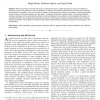Free Online Productivity Tools
i2Speak
i2Symbol
i2OCR
iTex2Img
iWeb2Print
iWeb2Shot
i2Type
iPdf2Split
iPdf2Merge
i2Bopomofo
i2Arabic
i2Style
i2Image
i2PDF
iLatex2Rtf
Sci2ools
TCBB
2008
2008
Statistical Characterization of Protein Ensembles
When accounting for structural fluctuations or measurement errors, a single rigid structure may not be sufficient to represent a protein. One approach to solve this problem is to represent the possible conformations as a discrete set of observed conformations, an ensemble. In this work, we follow a different richer approach and introduce a framework for estimating probability density functions in very high dimensions and then apply it to represent ensembles of folded proteins. This proposed approach combines techniques such as kernel density estimation, maximum likelihood, cross validation, and bootstrapping. We present the underlying theoretical and computational framework and apply it to artificial data and protein ensembles obtained from molecular dynamics simulations. We compare the results with those obtained experimentally, illustrating the potential and advantages of this representation.
| Added | 29 Dec 2010 |
| Updated | 29 Dec 2010 |
| Type | Journal |
| Year | 2008 |
| Where | TCBB |
| Authors | Diego Rother, Guillermo Sapiro, Vijay Pande |
Comments (0)

